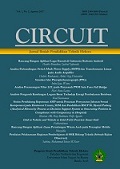Simulasi Sistem Hibrid Pembangkit Energi Surya, Angin, dan Generator Untuk Mengoptimalkan Pemanfaatan Daya Energi Terbarukan
DOI:
https://doi.org/10.22373/crc.v1i1.1381Keywords:
Hybrid, renewable energy, generatorAbstract
Electrical energy crisis related to the increasing population in an area will increase the electrical energy customers. Besides diminishing reserves of fossil energy that is required of alternative energy from renewable energy sources. The problem is in incorporating a potential source of renewable energy with a generator needs power generation hybrid, the hybrid system with a generator as backup energy utilization is less than optimal because when there was a deficit power generator takes over all of the power wasted in renewable energy generation. The purpose of study is to produce a hybrid system design between the generation of solar energy, wind energy and generator as support (support) when the power deficit in energy of renewable generator. Research Method in the design of hybrid system is a design block diagram consisting of solar panels, wind turbines, inverters, and generator. At this stage it has produced research outputs in the form of models of hybrid renewable energy generation systems and generators, then make a circuit simulation and measurement. The results of this research is a hybrid system that works adaptive- connected the generator to the system when the power deficit or increase the load to provide power support on renewable energy generation. This hybrid system with a capacity of 3.5 kW less power than the previous system with the composition generator 5.7 kW 2.2 kW of renewable energy consists of a 1 kW solar panels, wind turbines 1.3 kW and 1.3 kW generator voltage at 310V DC bus coupling, the voltage on the bus coupling AC 220V / 50 Hz, total load current at 16A. The percentage utilization of renewable energy rose from 11.73% to 24,94% and generator utilization fell from 24.50% to 16.74%.References
Isheng Wang, M Hashem Nehrir. Power Management of a Stand-Alone Wind/Photovoltaic/ Energy System. IEEE Transactions On Energy Conversion, VOL. 23, NO. 3, September 2008
S Rehman, A M Mahbub, Meyer, L M. Al-Hadhrami. Feasibility Study Of A Wind-Pv-Diesel Hybrid Power System For A Village. Center for Engineering Research, Research Institute, King Fahd University for Petroleum and Minerals, Dhahran-31261. Saudi Arabia. 2010
Hongxing Yang, Lin Lu, Wei Zhou. A novel optimization sizing for hybrid solar-wind power generation. RERG Sciene Dirrect, Elsevier. 2007
M H Nehrir, C Wang, K Strunz, H Aki, R Ramakumar, J Bing, Z. Miao, and Z. Salameh. A Review of Hybrid Renewable/Alternative Energy Systems for Electric Power Generation: Configurations, Control, and Applications. IEEE Transactions On Sustainable Energy, VOL. 2, NO. 4, October 2011
Luiz A. de S. Ribeiro, Osvaldo R. Saavedra, Shigeaki L. Lima, José G. de Matos. Isolated Micro-Grids with Renewable Hybrid Generation: The Case of Lençóis Island. ElectricalEngineering Institute, IEE-UFMA, Av. dos Portugueses s/n, Campus do Bacanga, CEP 65040-080, Brazil, 2008
Ahmed N. A. Miyatake M. A Stand-Alone Hybrid Generation System Combining Solar Photovoltaic and Wind Turbine with Simple Maximum Power Point Tracking Control. In Conf. Rec IEEE-IPEMC, 2006.
Boyle G. Renewable: power for a sustainable future. Oxford. 2004
Mendez L, Narvarte L, Marsinach A G. Izquierdo, P. Carrasco, L M Eyras, R. Centralized stand alone PV system in microgrid in Morocco. Photovoltaic Energy Conversion, 2003. Proceedings of 3rd World Conference on Volume 3, Page(s): 2326 – 2328. 2003
Chedid R, Raiman S. Unit sizing and control of hybrid wind-solar power systems. IEEE Transaction on Energy Conversion, Vol. 12, No. 1, pp. 79 – 85, 1997.
La Terra, G. Salvina G. Marco T. G. Optimal Sizing Procedure for Hybrid Solar Wind Power Systems Fuzzy Logic. In IEEE MELECOM, Benalmadena (Malaga). Spain, pp. 865 – 868, 2006
Tom Markvart, Luis Castafier. Practical Handbook of Photovoltaics: Fundamentals and Applicationsâ€, Elsevier Advanced Technology, The Boulevard. Langford Lane, Kidlington, OxfordOX5 lGB, UK, 2003.
Riad Chedid, Saifur Rahman. Unit Sizing And Control Of Hybrid Wind-Solar Power Systems. IEEE Transactions on Energy Conversion, Vol. 12, No. 1, March 1997
Dzulfiqar Rais Mushthafa, Mochamad Ashari, Vita Lystianingrum. Optimasi Sistem Pembangkit Listrik Tenaga Angin Menggunakan Maximum Power Point Tracker (MPPT) dengan Metode Gradient Approximation. Jurusan Teknik Elektro FTI-ITS, 2011
Lena Max. Energy Evaluation for DC/DC Converters in DC-Based Wind Farms. Division of Electric Power Engineering, Department of Energy and Environment, Chalmers University Of Technology, G¨oteborg, Sweden, 2007
Muhammad H Rashid. Power Electronics, Third Edition. Prentice Hall, United States of America, 2004
Sigit Prasetya, M Zaenal Efendi, Sutedjo. Pemanfaatan Harmonisa pada Beban Non Linier Sebagai Sumber EnergiMenggunakan Full Bridge DC-DC Converter dan Inverter. Electronic Engineering Polytechnic Institute of Surabaya (EEPIS), Indonesia, Indutrial Electronics Seminar. 2011.
Liem Ek Bien, Ishak Kasim, Wahyu Wibowo. Perancangan Sistem Hibrid Pembangkit Listrik Tenaga Surya Dengan Jala-Jala Listrik PLN Untuk Rumah Perkotaan. JETri, Volume 8, Nomor 1, Halaman 37-56, ISSN 1412-0372.
Aryuanto Soetedjo, Abraham Lomi, Yusuf Ismail Nakhoda. Pemodelan Sistem Pembangkit Listrik Hibrid Angin dan Surya. Jurusan Teknik Elektro, Fakultas Teknologi Industri, Institut Teknologi Nasional (ITN) Malang. 2010
Downloads
Published
Issue
Section
License
Authors who publish in CIRCUIT: Jurnal Ilmiah Pendidikan Teknik Elektro agree to the following terms:
- Authors retain copyright and grant the journal right of first publication with the work licensed under a Creative Commons Attribution-ShareAlike 4.0 International License (CC BY-SA 4.0) that allows others to share and adapt the work with an acknowledgement of the authorship and initial publication in this journal
- Authors are able to enter into separate, additional contractual arrangements for the non-exclusive distribution of the journal's published version of the work (e.g., post it to an institutional repository or publish it in a book), with an acknowledgment of its initial publication in this journal.
- Authors are permitted and encouraged to post their work online (e.g., in institutional repositories or on their website) prior to and during the submission process, as it can lead to productive exchanges, as well as earlier and greater citation of published work. (See The Effect of Open Acces)

